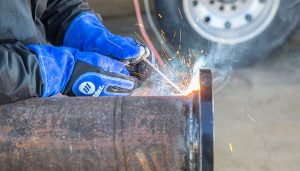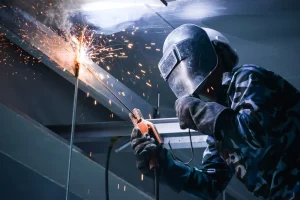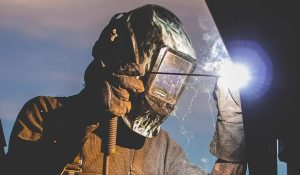When it comes to arc welding, there are 4 types of electrodes. These electrodes differ based on their properties. The basic guideline is to use an electrode that matches the base metal’s strength properties. However, you should also consider the type of base metal you’ll be welding, as these can also influence the type of stick electrode you need.
Which type of electrode is used in arc welding?
In arc welding, there are two types of electrodes: bare electrodes and light coated electrodes. Bare electrodes are made of bare metal, while light coated electrodes are made of metal coated with lime. Both types have the same overall diameter and length, but the difference between the two is in the coating. Light coated electrodes tend to be more stable, and the coating provides better protection from oxidation of the weld. They also produce a quieter arc.
The type of electrode you choose will depend on the type of welding you plan to do. The American Welding Society developed a system for naming electrodes. The electrode classification number consists of letters and numbers, and is usually engraved on the side of the welding rod. In the U.S., the first digit stands for electrode, and the two digits after the electrode indicate the minimum tensile strength of the weld.
The most popular electrode type is the 6010, which is designed to deliver deep penetration. It is used primarily for welding pipe and steel castings. This type can also be used for welding metals up to 1/2 in thick. However, it is important to note that 6010 electrodes can only be used with direct current (DC) welding equipment.
How do I choose an electrode for arc welding?
There are several types of electrodes to choose from. They differ in their mechanical properties and the way they operate with a particular welding power source. You should choose the correct electrode based on your base metal, joint fit-up, and welding positions. To make your welding process more efficient, you should know the basic types of electrodes.
If you are welding mild steel, you should use electrodes beginning with E60 and E70. The type of weld and the depth of penetration will also determine the type of electrode to use. If the weld will span a wide gap, you can use an E6013 electrode. If you are welding larger pieces, you should use an electrode with higher voltage.
Another factor that determines the type of electrode to use is the current. Using too little current can cause the arc to be unstable and difficult to start. Additionally, a low current will cause the electrode to stick to the work piece. Similarly, too high a current will overheat the electrode and can cause undercutting or burning of the material. An optimum current is somewhere in the middle of these ranges. This will ensure that the electrode isn’t overheated or burns the work.
Arc welding electrodes come with a variety of coatings. They can be thin or thick, or a combination of both. Whether you use an E6010 or E7024 electrode, the right coating will make your welding experience easier and ensure a stronger weld.
What are the 4 types of electrodes?
Electrodes are used in arc welding to create an electric arc. They are thin metal wires of different diameters and lengths. The most common electrodes used in MIG welding are spools of wire, while the electrodes used in SMAW and TIG welding resemble long wire rods. There are several types of electrodes, and some are specifically designed for different metals and currents.
The first type is bare electrodes, which are used in applications that do not require coated electrodes. The second type is a coated electrode. The coating of an electrode depends on its coating factor. The coating factor is a ratio of the diameter of the electrode to its core wire. The coating helps remove impurities from the arc. Light coatings help remove oxides and phosphorous from the arc, while medium coatings increase arc stability.
Tungsten electrodes are the most common type of electrodes. While they are commonly used in welding, they are less efficient than thorium electrodes. In addition, thoriated electrodes are more resistant to contamination. Pure tungsten electrodes are best for welding thin metals, but can be less effective on heavy metal. Tungsten-thorium electrodes have high current-carrying capacity and can withstand higher voltages. They also have better arc control.
How do I know which electrode to use?
Before using an electrode, you should know its composition and the type of power source it is compatible with. Some electrodes are only compatible with AC power while others require DC power. You can identify the type of electrode by its fourth digit on the AWS classification. The fourth digit indicates the type of electrode coating and welding current compatibility.
The tensile strength of the welded piece depends on the type of electrode. For example, a rod with an E symbol indicates it can handle 60,000 pounds of tensile strength per square inch, while an electrode with a 70 symbol means it can handle 70,000 pounds. Another indicator of a quality electrode is its sound. It should produce a sharp crackling sound with each movement. You can also judge the weld bead’s appearance.
The thickness of a part is another consideration. If the part is only a few millimeters thick, you should use a rod that is a little larger than the metal. For example, if you’re welding a two-millimeter thick plate, you should use an electrode with a diameter of 2.5 millimeters. The diameter of the electrode also depends on the material to be welded. The current setting of the electrodes varies according to the metal or alloy being welded. In some applications, a higher amperage will yield a stronger weld joint, but a lower one will make the joint weaker.
How do you choose electrode size?
When choosing an electrode size in arc welding, you will need to consider the thickness of the part to be welded. If the part is thin, you’ll want to choose an electrode with a diameter that is slightly larger than the thickness of the metal. For example, an electrode for a two-millimeter-thick plate should be 2.5 millimeters wide. The recommended sizes for electrodes are listed in the table below. These recommendations will vary according to the thickness of the part and the type of metal/alloy to be welded. It’s also important to know the recommended current setting for the metal/alloy you are welding. Often, manufacturers will specify a range of current for their electrodes. When welding with an over-head process, the current setting should be slightly lower than what is recommended for normal welding.
The next consideration is the electrode’s classification. Some types of electrodes are only suitable for AC power sources, while others are only suitable for DC power sources. The AS/NZS classification is helpful in determining the type of current an electrode is compatible with.
What is the easiest arc welding rod to use?
There are a few different types of arc welding rods. Some are easier to use than others, and some are more complicated. The easiest type of rod is one with a diameter of 1/8” or larger. These rods have good tip stability, but they can also produce a large amount of spatter. Thinner rods can be harder to weld with because they shake too much at the tip and make it difficult to strike the arc. Another type of rod is the cellulosic variety, which are harder to weld with because of their high heat and spatter. They also take a lot more time to learn to use and are not compatible with most welding machines.
Another type of rod is E6013. E6013 is one of the easiest to use because it produces a smooth arc and is easier to handle. It also produces less slag than other types of rod. It is also easier to start and stop than other types of rods, which makes it ideal for novice welders. E6013 is also very popular among welders because it is inexpensive and easy to find.
Another type of electrode is E7018. This electrode is commonly used in powerhouses, energy power plants, bridges, and factories. It has a high iron content, making it easy to weld. However, it must not be exposed to moisture. The best way to keep it dry is by storing it in a rod oven. E7018 is also the easiest arc welding rod to use.
Originally published at xpressmobilewelding.com




No comments:
Post a Comment